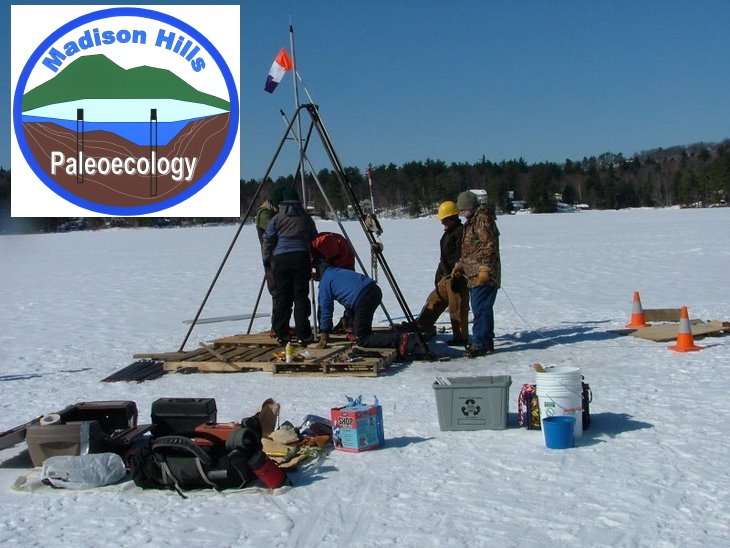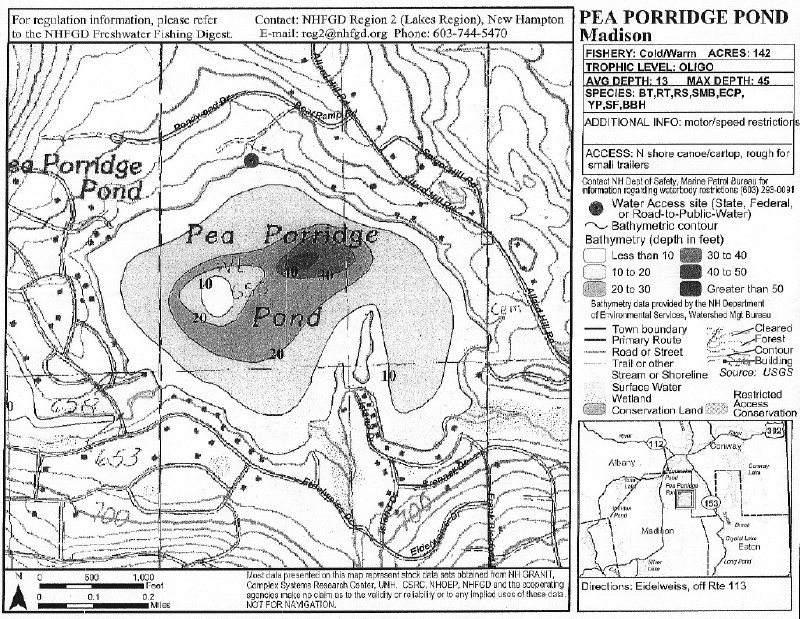
Figure 1

Figures 2a & 2b
After months of anticipation, the field portion of the Madison Hills Paleoecology Project will begin on Saturday, February 23, 2008.
It will start with the survey of the bottom of the Pond to find its deepest spot where, we hope, the thickest accumulation of post-glacial sediment is preserved for us to drill down to, sample, and analyze.
As you'll recall, if we can find a sufficient volume of organic material near the bottom of this sediment accumulation, we hope to obtain a carbon-14 date that will tell us when the last glacial ice left the Pond's basin and when its natural and ecological history sequence began. Then, by carefully analyzing the progressively younger layers in this sediment upwards from its base, we hope to at least partially reconstruct the sequence of climatic changes and related ecological environments that existed in the Pond's basin over the last 14,000 to 15,000 years.
The radar survey will be conducted by dragging Ground Penetrating Radar (GPR) equipment over the Pond's frozen surface along traverse lines located with a Global-Positioning System (GPS) instrument. These traverse lines will cross over the most likely deepest and shallowest parts of the Pond. Figure 1 above (click on it to enlarge) shows their approximate positions on the Pond's surface, based on the depth (bathymetry) map for the Pond published by the NH Fish & Game Department (see diagram on blog's main page below).
We have reason to believe, however, based on conversation with local fishermen, that the distribution of depths on this map may not be truly accurate, and so as we conduct the surveying, we will likely try other traverses until we have certainly located the deepest spot. We will blog-publish a final map when the all the activities associated with the surveying are complete.
Work on the 23rd will start early in the morning (see Social Postings for specific time and location) with the staking of the lines presently shown in the Figure 1 above. Once they are staked, the GPR equipment will be placed on a sled or sleds and slowly dragged by snowmobile along each of the lines. The GPR instrument sends radar signals downward through the ice and into the sediments on the bottom that bounce back and are recorded at varying speeds and intensities by the instruments, which after some computer processing, produce traverse profiles like the one shown in Figure 2a above. These profiles will show the depth to the bedrock or compact glacial deposit that forms the bottom of the basin and then some (hopefully most) of the layering that comprises the softer sediment accumulated within the basin since the glacial ice departed. Then as shown in Figure 2b above, we will use the information on these profiles to locate the 1 or more drilling sites we will use to sample the sediments, probably 2-3 weeks after the surveying is completed (stay tuned to the blog for schedule details).
The field work portion of the surveying will be conducted "snow or shine" and will be completed during the day on the 23rd. Data processing and related interpretive activity will be completed as soon as possible thereafter. You will kept informed via the blog's Scientific Postings.
Meantime, and most importantly, we would not be able to conduct this work and get the MPEP started without the scientific interest and generosity of a number of people and their firms who are donating time and equipment.
The GPR equipment, its field operation, and post-survey analyses are being provided by Hager Geoscience, Inc. of Woburn, MA, courtesy of its President, Dr. Jutta Hager, P.G. and its Vice President of Operations, Mario Carnevale, P.G.
The GPS instrumentation, its field operation, and pre-survey mapping are being provided by North American Reserve, LLC of Laconia, NH, courtesy of its President, Jeffrey Cloutier, P.G., its GPS field instrumentation expert, Michael Wright, P.G., and its CAD Systems Specialist, Shea Ripplinger.
The over-the-snow transportation, equipment sleds and accessories, and related logistical planning and support are being provided by Nordel Gagnon, well-known sage and resident on The Pond.
We'd also like to acknowledge the help and guidance of Dennis Deschane, long-time local fishermen who's search for the deepest spot and the biggest fish may end when this surveying is complete.
Finally, your attention is directed to the Social Postings portion of the blog where information will be provided regarding simultaneous activities on 2/23 that are related to the surveying work and the MPEP in general.
Please note that the next Scientific Posting will be made following completion of the survey's new Pond-bottom map and in advance of the drilling and sampling that will follow, well in advance of ice-out on the Pond.











